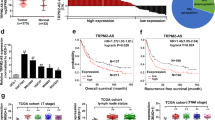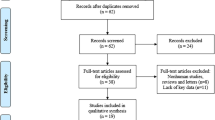Abstract
The purpose of this study is to investigate the role of the long noncoding RNA metastasis associated lung adenocarcinoma transcript 2 (MALAT2) in the prognosis of stage II/III gastric cancer (GC) patients. The expression of MALAT2 was evaluated in cancer tissues from 146 stage II/III GC patients undergoing radical resection and 60 paired normal samples using quantitative real-time reverse transcriptase PCR. Differences in the expression of MALAT2 between 23 GC and paired normal colonic mucosa samples were analysed with the Wilcoxon test. Relationships between the expression level of MALAT2, patient clinico-pathological parameters and disease-free survival and overall survival were analysed using the uni-variate Kaplan–Meier method and the multivariate COX regression model. The quantitative polymerase chain reaction results showed that MALAT2 was frequently over-expressed in cancer tissues and this over-expression was found to significantly correlate with lymph node metastasis and tumor stage. The ectopic expression of MALAT2 contributed to the migration of human GC SGC-7901 cells, whereas knockdown of MALAT2 inhibited the migration of the SGC-7901 cells in vitro. Further investigation into the underlying mechanisms responsible for the migratory effects revealed that MALAT2 induced the epithelial–mesenchymal transition (EMT) through an MEK/extracellular signal-regulated kinase-dependent mechanism as treatment with the MEK inhibitor, U0126, decreased migration and reversed the EMT in the MALAT2 over-expressed SGC-7901 cells. The expression of MALAT2 is upregulated in GC tissues, and a higher expression level of MALAT2 might serve as a negative prognostic marker in stage II/III GC patients which implies the potential application of MALAT2 in the therapeutic treatment of GC.
This is a preview of subscription content, access via your institution
Access options
Subscribe to this journal
Receive 12 print issues and online access
$259.00 per year
only $21.58 per issue
Buy this article
- Purchase on Springer Link
- Instant access to full article PDF
Prices may be subject to local taxes which are calculated during checkout





Similar content being viewed by others
References
Shao Y, Ye M, Jiang X, Sun W, Ding X, Liu Z et al. Gastric juice long noncoding RNA used as a tumor marker for screening gastric cancer. Cancer 2014; 120: 3320–3328.
Lin X, Yang M, Xia T, Guo J . Increased expression of long noncoding RNA ABHD11-AS1 in gastric cancer and its clinical significance. Med Oncol 2014; 31: 42.
Xu C, Shao Y, Xia T, Yang Y, Dai J, Luo L et al. lncRNA-AC130710 targeting by miR-129-5p is upregulated in gastric cancer and associates with poor prognosis. Tumour Biol 2014; 35: 9701–9706.
Liu G, Neumeister M, Reichensperger J, Yang RD . Therapeutic potential of human adipose stem cells in a cancer stem cell-like gastric cancer cell model. Int J Oncol 2013; 43: 1301–1309.
Liu Z, Shao Y, Tan L, Shi H, Chen S, Guo J et al. Clinical significance of the low expression of FER1L4 in gastric cancer patients. Tumour Biol 2014; 35: 9613–9617.
Shao Y, Chen H, Jiang X, Chen S, Li P, Ye M et al. Low expression of lncRNA-HMlincRNA717 in human gastric cancer and its clinical significances. Tumour Biol 2014; 35: 9591–9595.
Wang Y, Zhang D, Wu K, Zhao Q, Nie Y, Fan D et al. Long noncoding RNA MRUL promotes ABCB1 expression in multidrug-resistant gastric cancer cell sublines. Mol Cell Biol 2014; 34: 3182–3193.
Ishigami S, Arigami T, Uenosono Y, Okumura H, Kurahara H, Uchikado Y et al. Clinical implications of DLL4 expression in gastric cancer. J Exp Clin Cancer Res 2013; 32: 46.
Sasaki T, Kuniyasu H, Luo Y, Kitayoshi M, Tanabe E, Kato D et al. Increased phosphorylation of AKT in high-risk gastric mucosa. Anticancer Res 2013; 33: 3295–3300.
Shang Y, Zhang Z, Liu Z, Feng B, Ren G, Li K et al. miR-508-5p regulates multidrug resistance of gastric cancer by targeting ABCB1 and ZNRD1. Oncogene 2014; 33: 3267–3276.
Guo Q, Su N, Zhang J, Li X, Miao Z, Wang G et al. PAK4 kinase-mediated SCG10 phosphorylation involved in gastric cancer metastasis. Oncogene 2014; 33: 3277–3287.
Liechti GW, Goldberg JB . Helicobacter pylori salvages purines from extracellular host cell DNA utilizing the outer membrane-associated nuclease NucT. J Bacteriol 2013; 195: 4387–4398.
Li SG, Shao QS, Wang YY, Peng T, Zhao YF, Yang YJ et al. Effect of andrographolide on proliferation and apoptosis of gastric cancer BGC-823 cells. Zhonghua Wei Chang Wai Ke Za Zhi 2013; 16: 676–680 Chinese.
Cai C, Yu JW, Wu JG, Lu RQ, Ni XC, Wang SL et al. CD133 promotes the invasion and metastasis of gastric cancer via epithelial-mesenchymal transition. Zhonghua Wei Chang Wai Ke Za Zhi 2013; 16: 662–667 Chinese.
Emoto S, Yamaguchi H, Kamei T, Ishigami H, Suhara T, Suzuki Y et al. Intraperitoneal administration of cisplatin via an in situ cross-linkable hyaluronic acid-based hydrogel for peritoneal dissemination of gastric cancer. Surg Today 2014; 44: 919–926.
Guo LH, Li H, Wang F, Yu J, He JS . The tumor suppressor roles of miR-433 and miR-127 in gastric cancer. Int J Mol Sci 2013; 14: 14171–14184.
Liu QS, Zhang J, Liu M, Dong WG . Lentiviral-mediated miRNA against liver-intestine cadherin suppresses tumor growth and invasiveness of human gastric cancer. Cancer Sci 2010; 101: 1807–1815.
Kim YM, Kim IH, Nam TJ . Inhibition of AGS human gastric cancer cell invasion and proliferation by Capsosiphon fulvescens glycoprotein. Mol Med Rep 2013; 8: 11–16.
Kang D, Gong Y, Zhu Y, Li A, Dong N, Piao Y et al. The biological activity of H. pylori SlyD in vitro. Helicobacter 2013; 18: 347–355.
Emara M, Cheung PY, Grabowski K, Sawicki G, Wozniak M . Serum levels of matrix metalloproteinase-2 and -9 and conventional tumor markers (CEA and CA 19-9) in patients with colorectal and gastric cancers. Clin Chem Lab Med 2009; 47: 993–1000.
Buergy D, Fuchs T, Kambakamba P, Mudduluru G, Maurer G, Post S et al. Prognostic impact of extracellular matrix metalloprotease inducer: immunohistochemical analyses of colorectal tumors and immunocytochemical screening of disseminated tumor cells in bone marrow from patients with gastrointestinal cancer. Cancer 2009; 115: 4667–4678.
Rasul A, Khan M, Yu B, Ali M, Bo YJ, Yang H et al. Isoalantolactone a sesquiterpene lactone, induces apoptosis in SGC-7901 cells via mitochondrial and phosphatidylinositol 3-kinase/Akt signaling pathways. Arch Pharm Res 2013; 36: 1262–1269.
China LY, Sun DL, Duan YN, Zhang XJ, Wang N, Zhou RM et al. Association of functional polymorphisms in MMPs genes with gastric cardia adenocarcinoma and esophageal squamous cell carcinoma in high incidence region of North China. Mol Biol Rep 2010; 37: 197–205.
Zhao FJ, Kang CS, Cui XW, Song XM, Liu J, Zhang QY et al. The relationship of MMP-9, VEGF and PCNA expressions and their clinical significance in gastric adenocarcinoma. Zhonghua Nei Ke Za Zhi 2009; 48: 114–117 Chinese.
Lukaszewicz-Zajac M, Mroczko B, Szmitkowski M . The significance of metalloproteinases and their inhibitors in gastric cancer. Postepy Hig Med Dosw (Online) 2009; 63: 258–265 Review. Polish.
Adachi Y, Li R, Yamamoto H, Min Y, Piao W, Wang Y et al. Insulin-like growth factor-I receptor blockade reduces the invasiveness of gastrointestinal cancers via blocking production of matrilysin. Carcinogenesis 2009; 30: 1305–1313.
Vecchione L, Orditura M, Ciardiello F, De Vita F . Novel investigational drugs for gastric cancer. Expert Opin Investig Drugs 2009; 18: 945–955.
Du R, Xia L, Sun S, Lian Z, Zou X, Gao J et al. URG11 promotes gastric cancer growth and invasion by activation of beta-catenin signalling pathway. J Cell Mol Med 2010; 14: 621–635.
Kamata I, Ishikawa Y, Akishima-Fukasawa Y, Ito K, Akasaka Y, Uzuki M et al. Significance of lymphatic invasion and cancer invasion-related proteins on lymph node metastasis in gastric cancer. J Gastroenterol Hepatol 2009; 24: 1527–1533.
Peng TL, Chen J, Mao W, Song X, Chen MH . Aryl hydrocarbon receptor pathway activation enhances gastric cancer cell invasiveness likely through a c-Jun-dependent induction of matrix metalloproteinase-9. BMC Cell Biol 2009; 10: 27.
Nomura T, Kamio Y, Takasu N, Moriya T, Takeshita A, Mizutani M et al. Intrahepatic micrometastases around liver metastases from gastric cancer. J Hepatobiliary Pancreat Surg 2009; 16: 493–501.
Achyut BR, Ghoshal UC, Moorchung N, Mittal B . Transforming growth factor-B1 and matrix metalloproteinase-7 promoter variants induce risk for Helicobacter pylori-associated gastric precancerous lesions. DNA Cell Biol 2009; 28: 295–301.
Pertino MW, Lopez C, Theoduloz C, Schmeda-Hirschmann G . 1,2,3-triazole-substituted oleanolic Acid derivatives: synthesis and antiproliferative activity. Molecules 2013; 18: 7661–7674.
Hong KJ, Wu DC, Cheng KH, Chen LT, Hung WC . RECK inhibits stemness gene expression and tumorigenicity of gastric cancer cells by suppressing ADAM-mediated Notch1 activation. J Cell Physiol 2014; 229: 191–201.
Yang B, Jing C, Wang J, Guo X, Chen Y, Xu R et al. Identification of microRNAs associated with lymphangiogenesis in human gastric cancer. Clin Transl Oncol 2014; 16: 374–379.
Acknowledgements
This study was supported by Technology Development Foundation of Pudong District (PKJ2013-Y67).
Author Contributions
LL proposed the study. CF and TY performed the research and wrote the first draft. PEJ and WY collected and analyzed the data. All authors contributed to the design and interpretation of the study and to further drafts. CF and TY contributed equally to this paper. LL is the guarantor.
Author information
Authors and Affiliations
Corresponding author
Ethics declarations
Competing interests
The authors declare no conflict of interest.
Additional information
The Editor-in-Chief is retracting this article. Concerns were raised that the MALAT2 gene described does not exist. This has been confirmed by post-publication peer review: there is only one transcript, which is called MALAT1. None of the authors has responded to correspondence from the Editor-in-Chief or the Publisher about this retraction.
About this article
Cite this article
Chen, F., Tian, Y., Pang, Ej. et al. RETRACTED ARTICLE: MALAT2-activated long noncoding RNA indicates a biomarker of poor prognosis in gastric cancer. Cancer Gene Ther (2015). https://doi.org/10.1038/cgt.2015.6
Received:
Revised:
Accepted:
Published:
DOI: https://doi.org/10.1038/cgt.2015.6
This article is cited by
-
Retraction Note: MALAT2-activated long noncoding RNA indicates a biomarker of poor prognosis in gastric cancer
Cancer Gene Therapy (2020)
-
ZEB1-AS1 initiates a miRNA-mediated ceRNA network to facilitate gastric cancer progression
Cancer Cell International (2019)
-
LncRNAs with miRNAs in regulation of gastric, liver, and colorectal cancers: updates in recent years
Applied Microbiology and Biotechnology (2019)
-
Long non-coding RNAs: potential new biomarkers for predicting tumor invasion and metastasis
Molecular Cancer (2016)
-
Long non-coding RNA regulation of epithelial–mesenchymal transition in cancer metastasis
Cell Death & Disease (2016)



